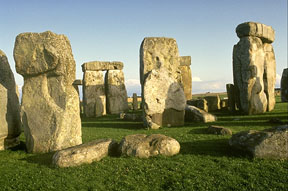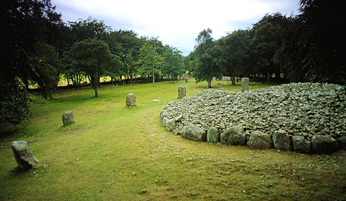This is photograph of the rows and rows of standing stones, Menhirs, in Carnac.
Click on image for full size
Courtesy of Corel Photography
The Stones of Carnac
The
stones of Carnac, France, are probably the most famous stones markings outside of those found at
Stonehenge in England. There are many, many stones at Carnac. And these stones are very old too, the earliest stones are from around 4,500 B.C.
The Carnac region contains many, many Menhir or upright stones. The Menhir stones are sometimes found in a line and sometimes in a circle. They can be anywhere from 0.8 meters high to 6.5 meters high. Rows of these stones can extend for distances of over a kilometer.
Some think these standing stones were signposts, others think they marked burial plots, still others think they were astronomical in nature. Research is going on now to try to find out if these stone markings served as sites for astronomy or whether they were aligned with the Sun or Moon in a special way.
The area is also home to Dolmens, burial places formed out of big stones. Dolmens would have a funeral chamber where people were buried and an access to that chamber. They basically look like a stone fort. There is another type of burial ground that was created by these Neolithic people (Neolithic people lived from ~4,500 B.C. to ~2,000 B.C.), the Tumulus. A Tumulus is a huge mound of earth and stones that covers a burial place. It looks like a well-formed hill of dirt, covered with grass and such. There was no way to get into a Tumulus burial ground.
You might also be interested in:

Many people are interested in the mysterious megalithic structures that can be found around the world. A megalithic structure is a ancient monument made of large stones. Megalith comes from Greek; "mega"
...more
The stone structures of England and France are very famous. But, there are also stone structures in Wales, Sweden, Germany, Portugal, Spain, and Russia. The most popular site in Wales is Pentre Ifan. Pentre
...more
The stone structures of England and France are very famous. In Italy, you'll also find standing stones, stone rings, and stone tombs. An example of these stone structures is in Fossa, Abruzzo, in Italy.
...more
People from Asia crossed the Bering Strait into North America. These people were first in this new land and so they are known as Native Americans. Over time, these people broke into tribes (as seen on
...more
"The movements of the heavenly bodies are an admirable thing, well known and manifest to all peoples. There are no people, no matter how barbaric and primitive, that do not raise up their eyes, take note,
...more
The stones of Carnac, France, are probably the most famous stones markings outside of those found at Stonehenge in England. There are many, many stones at Carnac. And these stones are very old too, the
...more
Not too far from Loch Ness, there lies three giant tombs made of stones. They are called the Balnuaran of Clava. The Balnuaran of Clava, giant tombs encased in stone, can be found close to Inverness in
...more














